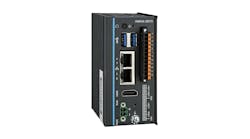Shankar Karanth is the head of global delivery at Axcend Automation & Software Solutions, a CSIA-certified member of the Control System Integrators Association (CSIA). Karanth is a seasoned solution consultant and a program management professional with about three decades of experience in various technology roles.
Tell us about your company's state-of-the-art simulation-software technology.
Shankar Karanth, head of global delivery, Axcend Automation & Software Solutions, a CSIA-certified member of the Control System Integrators Association: At Axcend, we've seen several innovative uses of simulation technology, especially with digital manufacturing becoming mainstream and with modern manufacturing becoming complex. The simulation tools we use depend upon the problem statement that we discover with our customers. Typically, simulation tools will be combined with other technology solutions to derive the best benefits for our customers.
Also read: Optimize designs of new product generations with simulation software
For example, we've made a digital twin powered by simulation by using Visual Components software and combining it with our custom-built application to feed in real-time data from the shopfloor and compare actual progress with benchmark scenarios, thus being able to predict outcomes more realistically.
We also have experience in using other software tools such as Simul8, PlantSim and Process Simulate for developing digital-factory concepts and Industry 4.0 solutions for discrete event simulation, process validation and fine tuning, human ergonomics analysis and virtual commissioning.
What have been the biggest improvements to simulation-software technology in the past five years?
Shankar Karanth, head of global delivery, Axcend Automation & Software Solutions, a CSIA-certified member of the Control System Integrators Association: The biggest improvements we've seen in simulation-software technology is the powerful digital-twin concept with real-time data feed helping vastly in higher productivity, safety, response times, quality and utilization.
Coupled with powerful 3D visualization and multi-physics capabilities, the simulation tools power the digital twins to move beyond static models and simulate real-life functions and predictive actions.
Simulation tools have also become multi-faceted and integration-friendly in the recent years. In the past, there were dedicated tools for different simulations such as mechanical system simulations, control logic simulations including PLC signals and responses, and operations simulations.
With integration capabilities, some simulation tools can take in industrial engineering data and simulate mechanical parameters like replicating speeds, loads, temperatures, pressures and inertia for the given operations data. This has enabled manufacturers to understand machine loading, capacity planning far better than before and enhance the virtual commissioning process to give better and more realistic results.
Also read: Data infusion enhances simulation software
Another area of improvement we've seen is the ease of use. Many simulation tools come with pre-built components and visual interfaces to build the models. This has accelerated complex model development without the need for expert knowledge and has eased up the process of changing the model parameters.
What's the most innovative or efficient simulation-software technology application you've ever seen or been involved with?
Shankar Karanth, head of global delivery, Axcend Automation & Software Solutions, a CSIA-certified member of the Control System Integrators Association: While we've developed many simulation-based solutions like virtual commissioning and process fine-tuning, a solution that we developed for an automotive-industry line builder to balance between performance and cost is what we would consider as an innovative solution using simulation tools.
We simulated an entire line to increase the throughput by 30% and reduce labor by 60%. We provided the user with what-if scenarios using various parameters like throughput, cycle time, equipment utilization and operator loading factor. This helped the line builder to recommend a smart line for the customer and take it forward for the actual commissioning process.
Another innovative solution we're building now is to combine artificial intelligence (AI) with discrete event simulation, which allows for better outcomes and predictability.
How has simulation-software technology benefitted from remote connectivity and networking?
Shankar Karanth, head of global delivery, Axcend Automation & Software Solutions, a CSIA-certified member of the Control System Integrators Association:The main benefit we see for simulation software from the developments in remote connectivity and networking is access to simulations. This means empowering multi-plant simulations with centralized expert teams and better remote support which was helpful during the COVID-19 crisis. Another by-product of better networks and connectivity is the ability to upgrade the software remotely and faster.
Also read: Simulation software benefits from graphics and ease-of-use improvements
Can you explain how improvements in simulation-software design and production have impacted industrial applications?
Shankar Karanth, head of global delivery, Axcend Automation & Software Solutions, a CSIA-certified member of the Control System Integrators Association: The ease of use and tools with pre-built components have impacted manufacturing positively. The improvements in simulation software have enabled better decision-making in several fronts and is not just limited to numerical modelling like in the past.
Also, simulation software is not just model-based but can be of several types and used in various stages within the industrial ecosystem. For example, from a product engineering and design perspective, simulation software has enabled industries to catch design defects much earlier than before, thus saving lots of cost to manufacturing enterprises. Similarly, in manufacturing and industrial engineering, the multivariate modelling in simulation software allows design of new processes, use of new materials and parts, and the ability to see the impact of engineering and process changes much ahead of implementing them.
How do simulation-software technologies figure into digital-twin platform models being used by manufacturers?
Shankar Karanth, head of global delivery, Axcend Automation & Software Solutions, a CSIA-certified member of the Control System Integrators Association: Visual and 3D simulation tools have great potential to integrate and plug in with digital-twin platforms. There are some tools that do these already. Sophisticated models such as production processes, robotic simulation and test rigs can augur well for digital twin used by manufacturers.
On top of the simulated models, digital twin can include predictability by using real-time data from the operations.
Digital twin can also enable playback, which will allow manufacturers to see how a process was done in real life, so they can fine-tune the same where necessary.
Also read: Simulation becomes part of the computer-aided lifecycle
A lot of improvement opportunities can be uncovered with the combination of simulation tools and digital twin.
When will simulation-software technology become IT-friendly enough that engineers/IT professionals are no longer required for installation and operation?
Shankar Karanth, head of global delivery, Axcend Automation & Software Solutions, a CSIA-certified member of the Control System Integrators Association: With the prevalence of cloud, we believe simulation software will also lend itself to the cloud where only the manufacturing subject matter expert will be needed to create the simulation models without help from IT. Many simulation tools are beginning to have web-based options with no installation and configuration needs.
What future innovations will impact the use of simulation-software technology in manufacturing operations?
Shankar Karanth, head of global delivery, Axcend Automation & Software Solutions, a CSIA-certified member of the Control System Integrators Association: Better graphical-processing and AI-processing engines will impact simulation software positively with the ability to model complex geometries that are closer to real-life. We believe the strides in this area will also make simulation tools more accessible and less expensive to propel usage in manufacturing operations. Another impactful innovation we foresee is the rise of concepts such as metaverse, which we envisage will make collaboration on simulation models easier and better.






